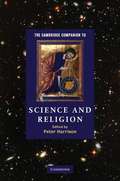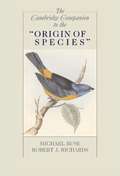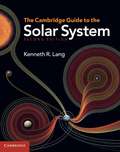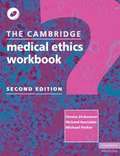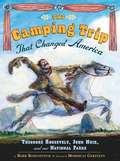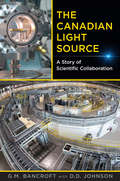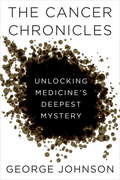- Table View
- List View
The Cambridge Companion to Galileo
by Peter MachamerNot only a hero of the scientific revolution, but after his conflict with the church, a hero of science, Galileo is today rivalled in the popular imagination only by Newton and Einstein. But what did Galileo actually do, and what are the sources of the popular image we have of him? This collection of specially-commissioned essays is unparalleled in the depth of its coverage of all facets of Galileo's work. A particular feature of the volume is the treatment of Galileo's relationship with the church. It will be of interest to philosophers, historians of science, cultural historians and those in religious studies.
The Cambridge Companion to Literature and Science (Cambridge Companions To Literature )
by Steven MeyerIn 1959, C. P. Snow lamented the presence of 'two cultures': the unbridgeable chasm of understanding, and knowledge between modern literature and modern science. Over the past twenty years, scholars in literature and science studies have worked diligently to interrogate relations between twentieth- and twenty-first-century literature and science as radically alienated from each other. <P><P>The Cambridge Companion to Literature and Science offers a roadmap to developments which have contributed to the emergence of reciprocal connections between the two areas of study. Weaving together theory and empiricism, individual chapters explore major figures - Shakespeare, Bacon, Darwin, Henry James, William James, Einstein; major genres - fiction, science fiction, poetry, dramatic works, science studies; and major theories and movements - pragmatism, critical theory, cognitive science, ecocriticism, cultural studies, affect theory, digital humanities, and empiricism. This book will be a key resource for scholars, graduate students, and undergraduate students alike.<P> Offers a new understanding of literature and science that demonstrates how an entire field of study has changed in recent decades as well as what the basis of that change is.<P> Describes the extensive overlap of literature and science with science studies, showing that the former is by no means just a subfield of the latter.<P> Promotes the integration of elements in the contemporary world that are often taken to be opposed, allowing readers to understand the limitations and imprecision of frequent claims for a literature/science ('two cultures') dichotomy.
The Cambridge Companion to Newton
by Smith George E. Rob IliffeSir Isaac Newton (1642–1727) was one of the greatest scientists of all time, a thinker of extraordinary range and creativity who has left enduring legacies in mathematics and physics. While most famous for his Principia, his work on light and colour, and his discovery of the calculus, Newton devoted much more time to research in chemistry and alchemy, and to studying prophecy, church history and ancient chronology. This new edition of The Cambridge Companion to Newton provides authoritative introductions to these further dimensions of his endeavours as well as to many aspects of his physics. It includes a revised bibliography, a new introduction and six new chapters: three updating previous chapters on Newton's mathematics, his chemistry and alchemy and the reception of his religious views; and three entirely new, on his religion, his ancient chronology and the treatment of continuous and discontinuous forces in his second law of motion.
The Cambridge Companion to Newton
by I. Bernard Cohen George E. SmithSir Isaac Newton (1642-1727) was one of the greatest scientists of all time, a thinker of extraordinary range and creativity who has left enduring legacies in mathematics and the natural sciences. In this volume a team of distinguished contributors examine all the main aspects of Newton's thought, including not only his approach to space, time, mechanics, and universal gravity in his Principia, his research in optics, and his contributions to mathematics, but also his more clandestine investigations into alchemy, theology, and prophecy, which have sometimes been overshadowed by his mathematical and scientific interests.
The Cambridge Companion to Science and Religion
by Peter HarrisonIn recent years, the relations between science and religion have been the object of renewed attention. Developments in physics, biology and the neurosciences have reinvigorated discussions about the nature of life and ultimate reality. At the same time, the growth of anti-evolutionary and intelligent design movements has led many to the view that science and religion are necessarily in conflict. This book provides a comprehensive introduction to the relations between science and religion, with contributions from historians, philosophers, scientists and theologians. It explores the impact of religion on the origins and development of science, religious reactions to Darwinism, and the link between science and secularization. It also offers in-depth discussions of contemporary issues, with perspectives from cosmology, evolutionary biology, psychology, and bioethics. The volume is rounded out with philosophical reflections on the connections between atheism and science, the nature of scientific and religious knowledge, and divine action and human freedom.
The Cambridge Companion to the "Origin of Species"
by Robert J. Richards Michael RuseThe Origin of Species by Charles Darwin is universally recognised as one of the most important science books ever written. The Origin of Species is also a work of great cultural and religious significance, in that Darwin maintained that all organisms, including humans, are part of a natural process of growth from simple forms. This Companion commemorates the 150th anniversary of the publication of the Origin of Species and examines its main arguments. Drawing on the expertise of leading authorities in the field, it also provides the contexts - religious, social, political, literary, and philosophical - in which the Origin was composed. Written in a clear and friendly yet authoritative manner, this volume will be essential reading for both scholars and students More broadly, it will appeal to general readers who want to learn more about one of the most important and controversial books of modern times.
The Cambridge Companion to the Philosophy of Biology
by Michael Ruse David L. HullThe philosophy of biology is one of the most exciting new areas in the field of philosophy and one that is attracting much attention from working scientists. This Companion, edited by two of the founders of the field, includes newly commissioned essays by senior scholars and up-and-coming younger scholars who collectively examine the main areas of the subject - the nature of evolutionary theory, classification, teleology and function, ecology, and the problematic relationship between biology and religion, among other topics. Up-to-date and comprehensive in its coverage, this unique volume will be of interest not only to professional philosophers but also to students in the humanities and researchers in the life sciences and related areas of inquiry.
The Cambridge Concise History of Astronomy
by Michael HoskinAstronomy is one of the oldest sciences, and one which has repeatedly led to fundamental changes in our view of the world. This book covers the history of our study of the cosmos from prehistory through to a survey of modern astronomy and astrophysics (sure to be of interest to future historians of twentieth-century astronomy). It does not attempt to cover everything, but deliberately concentrates on the important themes and topics. These include stellar astronomy in the seventeenth and eighteenth centuries, at the time subordinate to the study of the solar system, but the source of many important concepts in modern astronomy, and the Copernican revolution, which led to the challenge of ancient authorities in many areas, not just astronomy. This is an essential text for students of the history of science and for students of astronomy who require a historical background to their studies.
The Cambridge Double Star Atlas
by James Mullaney Wil Tirion MacEvoy, Bruce and Tirion, Wil and Mullaney, James Bruce MacevoyThis magnificent atlas contains the most attractive and interesting double and multiple stars for viewing with binoculars and telescopes. It is a must-have for stargazers who want to explore these fascinating objects. The first modern star atlas devoted to double and multiple stars, it plots over 2000 selected pairs of stars, each labeled with discoverer, catalog, and/or observatory designations. A superb introduction to this important class of celestial objects, it is spiral bound and printed in red-light friendly colours, making it ideal for use in the field. Written by experienced observer James Mullaney, and beautifully illustrated by renowned celestial cartographer Wil Tirion, it provides an easy-to-use 'celestial roadmap' to locate and identify double and multiple stars. Other deep-sky objects such as star clusters, nebulae, and galaxies are also included, and are color-coded for easy recognition and identification, making this an all-purpose observing reference.
The Cambridge Encyclopedia of Darwin and Evolutionary Thought
by Michael RuseThis volume is a comprehensive reference work on the life, labors, and influence of the great evolutionist Charles Darwin. With more than sixty essays written by an international group representing the leading scholars in the field, this is the definitive work on Darwin. It covers the background to Darwin's discovery of the theory of evolution through natural selection, the work he produced and his contemporaries' reactions to it, and evaluates his influence on science in the 150 years since the publication of Origin of Species. It also explores the implications of Darwin's discoveries in religion, politics, gender, literature, culture, philosophy, and medicine, critically evaluating Darwin's legacy. Fully illustrated and clearly written, it is suitable for scholars and students as well as the general reader. The wealth of information it provides about the history of evolutionary thought makes it a crucial resource for understanding the controversies that surround evolution today.
The Cambridge Encyclopedia of Human Paleopathology
by Arthur C. Aufderheide Conrado Rodríguez-MartínThis book was first published in 1998. The Cambridge Encyclopedia of Human Paleopathology is a major reference work for all those interested in identification of disease in human remains. Many diseases leave characteristic lesions and deformities on human bones, teeth and soft tissues that can be identified many years after death. This comprehensive volume includes most conditions producing effects recognizable with the unaided eye. Detailed lesion descriptions and over 300 photographs facilitate disease recognition and each condition is placed in context with discussion of its history, antiquity, etiology, epidemiology, geography, and natural history. Diseases affecting the soft tissues are also included as these are commonly present in mummified remains. This book will be an indispensable resource for paleopathologists, anthropologists, physicians, archaeologists, demographers, and medical historians alike.
The Cambridge Encyclopedia of the Language Sciences
by Patrick Colm HoganHave you lost track of developments in generative linguistics, finding yourself unsure about the distinctive features of minimalism? Would you like to know more about recent advances in the genetics of language, or about right hemisphere linguistic operation? The Cambridge Encyclopedia of the Language Sciences addresses these issues, along with hundreds of others. It includes basic entries for those unfamiliar with a given topic and more specific entries for those seeking more specialized knowledge. It incorporates both well-established findings and cutting-edge research and classical approaches and new theoretical innovations. The volume is aimed at readers who have an interest in some aspect of language science but wish to learn more about the broad range of ideas, findings, practices, and prospects that constitute this rapidly expanding field, a field arguably at the center of current research on the human mind and human society.
The Cambridge Guide to the Solar System
by Kenneth R. LangRichly illustrated with full-color images, this book is a comprehensive, up-to-date description of the planets, their moons, and recent exoplanet discoveries. This second edition of a now classic reference is brought up to date with fascinating new discoveries from 12 recent Solar System missions. Examples include water on the Moon, volcanism on Mercury's previously unseen half, vast buried glaciers on Mars, geysers on Saturn's moon Enceladus, lakes of hydrocarbons on Titan, encounter with asteroid Itokawa, and sample return from comet Wild 2. The book is further enhanced by hundreds of striking new images of the planets and moons. Written at an introductory level appropriate for undergraduate and high-school students, it provides fresh insights that appeal to anyone with an interest in planetary science. A website hosted by the author contains all the images in the book with an overview of their importance. A link to this can be found at www.cambridge.org/solarsystem.
The Cambridge Handbook of Artificial Intelligence
by Keith Frankish William M. RamseyArtificial intelligence, or AI, is a cross-disciplinary approach to understanding, modeling, and creating intelligence of various forms. It is a critical branch of cognitive science, and its influence is increasingly being felt in other areas, including the humanities. AI applications are transforming the way we interact with each other and with our environment, and work in artificially modeling intelligence is offering new insights into the human mind and revealing new forms mentality can take. <P> This volume of original essays presents the state of the art in AI, surveying the foundations of the discipline, major theories of mental architecture, the principal areas of research, and extensions of AI such as artificial life. With a focus on theory rather than technical and applied issues, the volume will be valuable not only to people working in AI, but also to those in other disciplines wanting an authoritative and up-to-date introduction to the field.
The Cambridge Handbook of Biolinguistics
by Cedric Boeckx Kleanthes K. GrohmannBiolinguistics involves the study of language from a broad perspective that embraces natural sciences, helping us better to understand the fundamentals of the faculty of language. This Handbook offers the most comprehensive state-of-the-field survey of the subject available. A team of prominent scholars working in a variety of disciplines is brought together to examine language development, language evolution and neuroscience, as well as providing overviews of the conceptual landscape of the field. The Handbook includes work at the forefront of contemporary research devoted to the evidence for a language instinct, the critical period hypothesis, grammatical maturation, bilingualism, the relation between mind and brain and the role of natural selection in language evolution. It will be welcomed by graduate students and researchers in a wide range of disciplines, including linguistics, evolutionary biology and cognitive science.
The Cambridge Handbook of Forensic Psychology
by Jennifer M. Brown Elizabeth A. CampbellForensic psychology has developed and extended from an original, narrow focus on presenting evidence to the courts to a wider application across the whole span of civil and criminal justice, which includes dealing with suspects, offenders, victims, witnesses, defendants, litigants and justice professionals. This handbook provides an encyclopedic-style source regarding the major concerns in forensic psychology. It is an invaluable reference text for practitioners within community, special hospital, secure unit, prison, probation and law enforcement forensic settings, as well as being appropriate for trainees and students in these areas. It will also serve as a companion text for lawyers and psychiatric and law enforcement professionals who wish to be apprised of forensic psychology coverage. Each entry provides a succinct outline of the topic, describes current thinking, identifies relevant consensual or contested aspects and alternative positions. Readers are presented with key issues and directed towards specialized sources for further reference.
The Cambridge Handbook of Physics Formulas
by Graham WoanThe Cambridge Handbook of Physics Formulas is a quick-reference aid for students and professionals in the physical sciences and engineering. It contains more than 2000 of the most useful formulas and equations found in undergraduate physics courses, covering mathematics, dynamics and mechanics, quantum physics, thermodynamics, solid state physics, electromagnetism, optics and astrophysics. An exhaustive index allows the required formulas to be located swiftly and simply, and the unique tabular format crisply identifies all the variables involved. The Cambridge Handbook of Physics Formulas comprehensively covers the major topics explored in undergraduate physics courses. It is designed to be a compact, portable, reference book suitable for everyday work, problem solving or exam revision. All students and professionals in physics, applied mathematics, engineering and other physical sciences will want to have this essential reference book within easy reach.
The Cambridge History of Capitalism: From Ancient Origins to 1848
by Jeffrey G. Williamson Larry NealThe first volume of The Cambridge History of Capitalism provides a comprehensive account of the evolution of capitalism from its earliest beginnings. Starting with its distant origins in ancient Babylon, successive chapters trace progression up to the 'Promised Land' of capitalism in America. Adopting a wide geographical coverage and comparative perspective, the international team of authors discuss the contributions of Greek, Roman and Asian civilizations to the development of capitalism, as well as the Chinese, Indian and Arab empires. They determine what features of modern capitalism were present at each time and place, and why the various precursors of capitalism did not survive. Looking at the eventual success of medieval Europe and the examples of city-states in northern Italy and the Low Countries, the authors address how British mercantilism led to European imitations and American successes, and ultimately, how capitalism became global.
The Cambridge Illustrated Glossary of Botanical Terms
by Michael Hickey Clive KingThis beautifully illustrated glossary comprises over 2400 terms commonly used to describe vascular plants. The majority are structural terms referring to parts of plants visible with the naked eye or with a x10 hand lens, but some elementary microscopical and physiological terms are also included, as appropriate. Each term is defined accurately and concisely, and whenever possible, cross referenced to clearly labelled line drawings made mainly from living material. The illustrations are presented together in a section comprising 127 large format pages, within which they are grouped according to specific features, such as leaf shape or flower structure, so allowing comparison of different forms at a glance. The illustrations therefore provide a unique compilation of information that can be referred to independently of the definitions. This makes the glossary a particularly versatile reference work for all those needing a guide to botanical terminology and plant structure.
The Cambridge Medical Ethics Workbook
by Donna Dickenson Richard Huxtable Michael ParkerThis new edition of The Cambridge Medical Ethics Workbook builds on the success of the first edition by working from the 'bottom up', with a widely praised case-based approach. A variety of guided exercises are supplemented by short papers and commentaries on legal and ethical issues, challenging readers to develop their own analyses and recommendations. Chapters cover death, genetics, new reproductive technologies, research, long-term care, mental health, children and young people, allocation of scarce resources, and general issues about autonomy and patient choice. An appendix discusses the use of this book in teaching, along with a full bibliography, list of Kennedy Institute keywords, and suggestions for further reading. An interactive CD-ROM packaged with the book provides extra cases, a glossary, legal references and the chance to record a personal learning diary. Its simple, clear style makes this book ideal for individual reference and as a set text for group teaching.
The Cammy Awards
by Amy TaoFind out which animals get the Cammy Award for being the best desert dwellers! Surviving in the desert heat can be dangerous–from deadly shifting sands to a lack of food and water, learn how animals like the Dromedary camel uses its eyelids to shield it from swirling sand, how Sandgrouse chicks soak up water from feathers on their fathers belly, and how the kangaroo rat never takes a drink!
The Camping Trip That Changed America: Theodore Roosevelt, John Muir, and Our National Parks (Into Reading, Read Aloud Module 7 #2)
by Mordicai Gerstein Barb RosenstockNIMAC-sourced textbook
The Camping Trip that Changed America
by Barbara Rosenstock Mordecai GersteinCaldecott medalist Mordicai Gerstein captures the majestic redwoods of Yosemite in this little-known but important story from our nation's history. In 1903, President Theodore Roosevelt joined naturalist John Muir on a trip to Yosemite. Camping by themselves in the uncharted woods, the two men saw sights and held discussions that would ultimately lead to the establishment of our National Parks.
The Canadian Light Source: A Story of Scientific Collaboration
by Dennis Johnson G. Michael BancroftThe creation of the Canadian Light Source (CLS) in Saskatoon, which began operation in 2004, was the largest science project in Canada in the last fifty years. The multi-beam facility operates more than five thousand hours per year and has more than one thousand Canadian and international users from a wide range of science, medical, and engineering disciplines. This book describes the decades of intense research from many scientists to justify this project and the resulting outstanding research covering many areas of the physical, biological, medical, and agricultural sciences. With personal accounts and frank narration, this book describes the long history leading to the CLS, beginning in Saskatoon in the 1930s. The core of the book highlights the remarkable and unselfish collaboration and cooperation of a few hundred people from Canadian and international universities, governments, and industry, showcasing how the Canadian Light Source represents pure and applied research at its finest.
The Cancer Chronicles: Unlocking Medicine's Deepest Mystery
by George JohnsonWhen the woman he loved was diagnosed with a metastatic cancer, science writer George Johnson embarked on a journey to learn everything he could about the disease and the people who dedicate their lives to understanding and combating it. What he discovered is a revolution under way--an explosion of new ideas about what cancer really is and where it comes from. In a provocative and intellectually vibrant exploration, he takes us on an adventure through the history and recent advances of cancer research that will challenge everything you thought you knew about the disease. Deftly excavating and illuminating decades of investigation and analysis, he reveals what we know and don't know about cancer, showing why a cure remains such a slippery concept. We follow him as he combs through the realms of epidemiology, clinical trials, laboratory experiments, and scientific hypotheses--rooted in every discipline from evolutionary biology to game theory and physics. Cogently extracting fact from a towering canon of myth and hype, he describes tumors that evolve like alien creatures inside the body, paleo-oncologists who uncover petrified tumors clinging to the skeletons of dinosaurs and ancient human ancestors, and the surprising reversals in science's comprehension of the causes of cancer, with the foods we eat and environmental toxins playing a lesser role. Perhaps most fascinating of all is how cancer borrows natural processes involved in the healing of a wound or the unfolding of a human embryo and turns them, jujitsu-like, against the body. Throughout his pursuit, Johnson clarifies the human experience of cancer with elegiac grace, bearing witness to the punishing gauntlet of consultations, surgeries, targeted therapies, and other treatments. He finds compassion, solace, and community among a vast network of patients and professionals committed to the fight and wrestles to comprehend the cruel randomness cancer metes out in his own family. For anyone whose life has been affected by cancer and has found themselves asking why?, this book provides a new understanding. In good company with the works of Atul Gawande, Siddhartha Mukherjee, and Abraham Verghese, The Cancer Chronicles is endlessly surprising and as radiant in its prose as it is authoritative in its eye-opening science.


